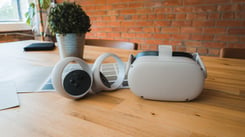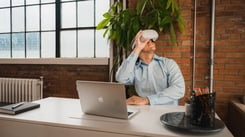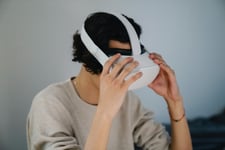If you have been following our monthly Yulio VR Employee Highlight Reel, you would know our team is made up of many bright and talented VR experts. This week, we were curious to know when everyone’s first experience with VR was. We went around the office and asked everyone these questions:
When was your first VR experience?
What was the experience?
What is the most notable change/improvements the industry has made thus far?

Let’s explore who in our team had the most recent experience with VR.
2018 - Rachel
I first experienced VR when I joined our Yulio team. I remember Dana passed me the Oculus Go to view one of our sample VR projects, and I was completely shocked - it truly felt I was in a room bigger than the small meeting room we were in. It definitely reminded me of the TARDIS (for all my Dr. Who fans out there) phenomenon.
Although I’ve only been recently introduced to VR, there have already been significant improvements. For one, the hardware upgrades like the Oculus Quest will have huge implications, especially for business. We played around with the headset two days ago, and I must say the experience is really impressive. In addition, it’s really exciting seeing all the businesses arming their workflow with VR.
2018 - Elena
My first VR experience was strapping into the station at the back of the office, and shooting down zombies! It was a really cool experience, but I remember the first thing I tried to do was look down. I couldn’t see my legs which made me scared and numb for a minute, but it was fine afterwards. I thought it was really interesting how seeing something in VR could have an outward effect on your body.
I’m not a gamer, but in a year, I’ve seen how the business sector has changed. Many industries like retail and medicine have been transformed by VR. It’s a great cost-effective way to train people, especially medical staff. Plus, consumers are now expecting more experiences than just the product itself. People are getting tired of traditional marketing methods, and this is a new way to bring a new and memorable experience to your customers.
2017 - Jim
Ian walked me through my first VR experience, and it was absolutely incredible. He showed me the full extent of VR and the different experiences you can have with just one piece of technology. Part of the presentation was a hotspot walkthrough, which is what we do at Yulio, of a VR project and looking around the space. The other was experiencing and manipulating an environment through a video game.
I’d say the most notable changes to VR are happening right now, and it’s happening in two phases. One part of it is the fact that VR now has mobile capabilities, allowing for easier access to the technology. All I need to do is simply attach a Homido to my phone, not to mention the transformational release of the Oculus Quest. The second aspect is that now you have the ability to have a better understanding of where you are relative to a space. It’s absolutely incredible.
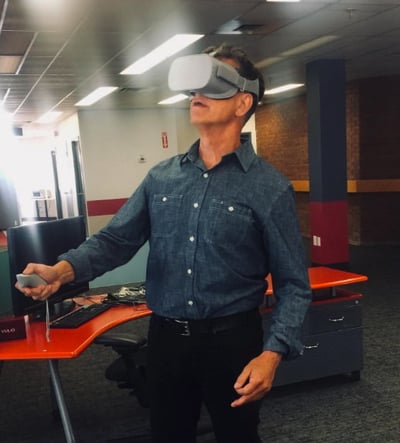
2017 - Steven
I first experienced VR when Ian brought the rig into the office. I believe we were walking around in a virtual world, something similar to Mario. Back then, the graphics weren’t great and it was quite pixelated. Plus, you needed to hold controllers that didn’t have great tracking. Now, the movement is much more accurate and captures your hand movement very well. The overall quality of the VR experience is much better and more immersive, especially with the emergence of advanced eye and head tracking.
2017 - Oussama
I remember my first VR experience was playing Arizona Sunshine in the office, and I definitely noted that the illusion wasn’t great, especially compared to what we have now. I would say the most notable change since the first time I used VR is the portability of the headset. VR hardware is getting smaller and more accessible for anyone to use. As well, the next evolution of the headsets will include six degrees of freedom, which will make the VR experience even more awesome.
2016 - Dana
I went to school for architecture, and when I started at Yulio, I used our Sketchup Plugin to see my own model in VR. I got chills when I saw it in VR. When you’re in architecture school, and when you’re working on a project for so long, since you’re a student, it will never get build. Now, being able to stand inside of something you worked on for months and months is really cool and rewarding.
Although VR still has a ways to go, the biggest change is the accessibility to the VR headsets. Anyone can now go to Best Buy and purchase a VR headset when previously this would never happen. Plus the overall attitude towards VR has been a huge change. Most people are confronting their fear of trying something new and unfamiliar with to combat being left behind.
2016 - Rob
I was at a tech foncerence when they strapped me into a 20lb+ headset with heavy-duty gloves. Suddenly, I was hanging on for my life about 100 meters up a sheer rock face. I’ve done quite a bit of rock climbing in a previous life, and even though the graphics quality wasn’t great, I felt instantly connected to the experience. It felt real enough to convince me that this technology was going to go beyond gaming and entertainment.
I think the release of the Oculus Quest may be a step into being the big “ground shifting” improvement. The headsets have seen many improvements, however, they have been incremental in nature. To name a few, better head and eye tracking, improved navigation, and greater processing power have all contributed to making the VR experience more immersive. Plus, we have entered an era where there is no longer a dependence on phones for a standalone VR headset. I am also quite excited to see how the introduction of 5G and greater availability of cloud-based, low-cost rendering services could provide the catalyst for the next round of exponential improvements in the VR user’s experience.
2015 - Ilan
I believe my first VR experience was using the Samsung Gear VR looking around a hotel. I definitely liked the stereo effects because it’s not flat, and you can clearly see distance and depth -- it’s more than a picture. It’s using real-world units to judge how to scale something that would look real in our reality whereas a normal picture gives no sense of scale.
I never expected the industry to blow up like this. We mostly work with 3 degrees of freedom, and since our platform is mostly made for mobile VR, the quality of the experience only goes as far as your phone’s performance. Now, headsets are supporting 6 degrees of freedom, giving a greater and more immersive VR experience.
2014 - Dani
It was at the SIGGRAPH conference in 2014 where they set up a contraption that would simulate flying like a bird. The experience was absolutely incredible. I literally felt like I was flying, especially with the added fan blowing in my hair giving a greater immersive effect. I’m amazed at how far VR has come. I knew that VR wasn’t a new thing, but I didn’t know how the industry was going to progress. I really thought VR would only be used in gaming, not training, visualizations, and what we do at Yulio.
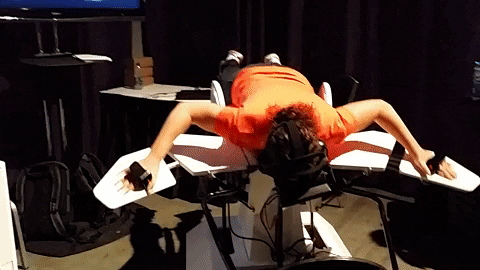
The headsets are getting smaller and smaller. Previously, the cables were so heavy that the VR experience required an extra person holding a cable behind the person in the headset. Plus, the headset required a lot of space, often taking up a whole room for the experience. With the headsets available now, the industry has really improved the accessibility of the headsets as well as what is required of the person wanting to use the technology.
2014 - Geoffrey
I first experienced VR at a student showcase at the University of Ontario Institute of Technology. Students would show off their projects in VR, and I was walking through the booths trying the headsets out. I believe the headset was the Oculus Rift DK1. Although it was really cool, it was a nauseating experience.
I would say the most notable advancement is the release of the Oculus Quest. It's a more mainstream headset, and you can set it up anywhere just like the Nintendo Switch. The headset doesn’t require any external sensors, and it’s at a relatively affordable price.
2013 - Kan
Ian brought a VR rig to the office, and I experienced a dinosaur screaming and chasing me -- it was amazing! The quality, of course, isn’t as good as what we have today. However, at the time, it was a whole new world and was really awesome. The experience made you feel like you were actually there.
I feel like the tracking technology has come a long way. We now have really advanced head and eye tracking, allowing users to have a very immersive experience. I also heard that what’s next on the tracking horizon is finger tracking! There is still a ways to go, but there are definitely a lot of improvements in VR.
2002 - Steven
I first experienced VR at a video game arcade where they had a giant rig that you got strapped into. It was definitely an amazing experience since it was a brand new concept that I’ve never seen before. The graphics at the time were pretty low quality, even by the standard back then for video games. On top of that, the headset itself was quite clunky, and since it was tethered, your movements were pretty restricted due to the cable. Plus, it was kind of a strange experience since everyone was looking at the guy strapped into a huge machine.
The biggest change in the industry has definitely got to be the tie between mobility and accessibility. You have machines like the Oculus Go and Quest where you can pick up the headset at any electronic store for a reasonable price. The feature that is especially useful for me is that you can take the headsets around anywhere. This opens so many doors in terms of how you can get your content out and share it with others. It’s definitely beneficial for sales people as you don’t need to worry about carrying a bunch of equipment like if it was a tethered experience.
1999 - Christine
My first VR experience was at Disney World in their “Technology of the Future” exhibit in EPCOT. I remember it was an hour-long lineup, but it was definitely a super cool experience, kind of like a TRON environment. I remember the headset was like a giant helmet in a protected circle area, and the experience required 2-3 staff to support the individual user.
.jpg?width=600&name=60688257_670996076684463_7490451564411224064_n-1-1024x768%20(1).jpg)
Today, VR is much more practical where you can slip on a Homido on your phone to access your VR project. It’s been getting easier to adopt VR into business. Back then, VR experiences were mostly centred around fantasy or experiencing something you never could, like visiting the moon. Now, it’s about experiencing something you can see in a picture. VR has the potential to be a major disruptor in numerous industries like architecture, interior design, and retail to name a few.
1997 - Ian
The first experience I had with VR was the first generation of microdisplays and head tracking, most of which was the very early head mounted tracking display prototypes that never made it to the mass market. Although it was pretty rudimentary, it was indicative of direction VR will take in the future. You saw there was a lot of potential, however, it wasn’t advanced enough to convincingly and completely displace you into another environment.
Accessibility is absolutely the biggest groundbreaker. The early prototypes were millions of dollars to build, which meant that it was prohibitively for the Enterprise R&D class. The Quest and Rift S for going, what, $400? That’s a lot of people’s monthly coffee bill! However, it’s also important to note that hardware without content is nothing. There is a growing ecosystem of inexpensive and accessible camera-based capture, with a high-quality stereoscopic image starting at $420 (previously you’d be looking at $6,000). Content and hardware is absolutely the biggest aspect of blowing up the market.
1996 - Lev
My first VR experience was back in 1996, and I found it was a really awesome idea, but I also expected it to suck. At the time, the quality was at 300x200 per eye, plus you can only rotate and move your head so much. The first experience definitely made me feel nauseous and I couldn’t stay on the rig for very long.
VR has definitely come a long way, but there is still a long way to go. Previously, there was no eye adjustment, which meant you would have to place the headset on your head just right for a mediocre VR experience. Now the headsets are very advanced, and you don’t need to do any external adjustments for a high-quality experience. Although this generation of headsets (referring to the Quest an Rift S) are alright, I’m really excited for the next line of headsets to come.
Were you surprised by who first experienced VR at Yulio? Tell us when you first experienced VR and the biggest improvements you’ve seen to the technology over our social media platforms! Follow us on Facebook, Twitter or Linkedin! For more information on how to integrate VR into your business for maximum ROI, check out our Whitepaper.



.jpg?width=245&height=150&name=active-adult-beautiful-1799244%20(1).jpg)
